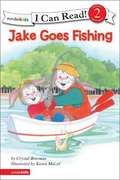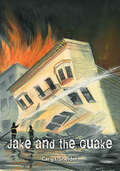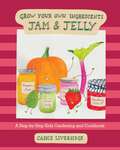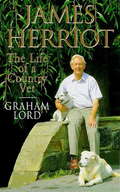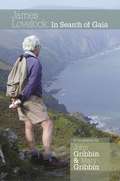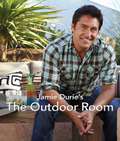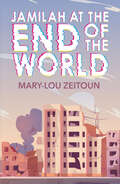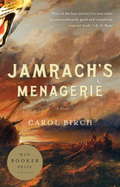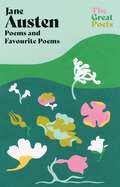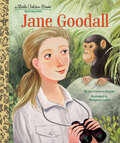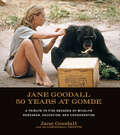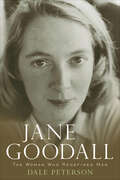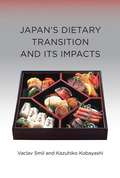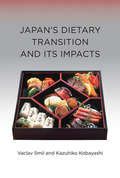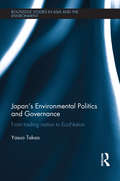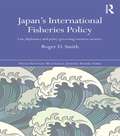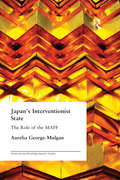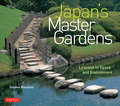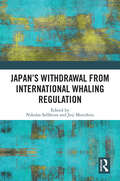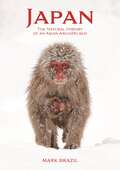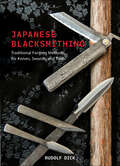- Table View
- List View
Jake Goes Fishing (I Can Read! #Level 2)
by Crystal BowmanSpilled worms and a snagged hook threaten to ruin Jake's fishing trip. He wants to have fun with his father. But what if there are no fish to bring home for dinner? Although he makes some mistakes at first, Jake spends a wonderful day fishing with his father, then enjoying a very special fish dinner. Picture descriptions present.
Jake and the Quake
by Cary SneiderWhen Jake finds an unusual rock in the cliffs under the Golden Gate bridge, he embarks on an adventure of discovery that will bring him new friends, new knowledge, and even the confidence to face a devastating earthquake.
Jam and Jelly: A Step-by-Step Kids Gardening and Cookbook (Grow Your Own Ingredients #1)
by Cassie LiversidgeGrow It! Harvest it! Cook it! Eat it! Yummy Jam and Jelly for You and Your Family! There is nothing like eating homemade jam and jelly. Now you can learn how to grow the plants they come from and then make your own. Strawberry jam, pumpkin jam, mint jelly, and rhubarb jelly are perfect for so many occasions, from summer picnics to weekend breakfasts and everyday snacks. You will learn how to grow strawberries, pumpkins, mint, and rhubarb with the fun instructions inside. Then you can harvest your ingredients and head to the kitchen to learn how to transform them into these delicious treats! They can make very special gifts, as well, if you can bear to part with them. Have fun getting your hands dirty while growing your own ingredients. Most of all, get ready to eat the best food in the world—food you have grown it yourself! This is the third book in the Grow Your Own series, after Pasta Sauce! and Ice Cream!
James Herriot's Dog Stories
by James HerriotFrom the Book Jacket "[Herriot has the] ability to touch readers with his stories of pets and their eccentric owners and to bring them into the harshly beautiful world of the Yorkshire dales." -Chicago Tribune "FIFTY TOUCHING AND MEMORABLE DOG STORIES FROM THE VETERINARIAN AND MASTER STORYTELLER OF YORKSHIRE . . . AN EXTRA SPECIAL TREAT!" -Kirkus Reviews "Herriot's real gift lies in keeping us intrigued with his human and dog characters . . . Herriot teaches us how unpredictable and joyous life can be." -San Francisco Chronicle "James Herriot has become one of America's most beloved storytellers." -Times-Dispatch (Richmond, VA)
James Herriot: The Life of a Country Vet
by Graham LordAlf Wight, a modest Scottish writer, better known as James Herriot, wrote books that became worldwide best sellers, films, audiobooks, and a much-loved television show. In The Life of a Country Vet, Graham Lord has written a detailed and affectionate biography of this remarkable man. Lord carefully documents Wight's life, beginning with his childhood in Glasgow and his years in veterinary college. Following his development as a writer, the source of his pen name, and his struggles to get published. Along the way, we encounter some extraordinary events and hidden tragedies in this seemingly magical life. Millions of fans laughed and cried at Wight's delightful stories of life as a vet. Lord reveals that some of the stories were utterly true, and some were utterly fictional. He illuminates the real relationships between the memorable characters that inhabit the books. This warm yet insightful portrait by Lord - who knew his subject very well - will be enjoyed by Wight's myriad of fans. It also dispels the myths that have grown around the life of one of the most famous and deeply loved vets the world has known.
James Herriot: The Life of a Country Vet
by Graham LordAlf Wight, a modest Scottish writer, better known as James Herriot, wrote books that became worldwide best sellers, films, audiobooks, and a much-loved television show. In The Life of a Country Vet, Graham Lord has written a detailed and affectionate biography of this remarkable man. Lord carefully documents Wight's life, beginning with his childhood in Glasgow and his years in veterinary college. Following his development as a writer, the source of his pen name, and his struggles to get published. Along the way, we encounter some extraordinary events and hidden tragedies in this seemingly magical life. Millions of fans laughed and cried at Wight's delightful stories of life as a vet. Lord reveals that some of the stories were utterly true, and some were utterly fictional. He illuminates the real relationships between the memorable characters that inhabit the books. This warm yet insightful portrait by Lord - who knew his subject very well - will be enjoyed by Wight's myriad of fans. It also dispels the myths that have grown around the life of one of the most famous and deeply loved vets the world has known.
James Lovelock: In Search of Gaia
by John Gribbin Mary GribbinIn 1972, when James Lovelock first proposed the Gaia hypothesis--the idea that the Earth is a living organism that maintains conditions suitable for life--he was ridiculed by the scientific establishment. Today Lovelock's revolutionary insight, though still extremely controversial, is recognized as one of the most creative, provocative, and captivating scientific ideas of our time. James Lovelock tells for the first time the whole story of this maverick scientist's life and how it served as a unique preparation for the idea of Gaia. Drawing on in-depth interviews with Lovelock himself and unprecedented access to his private papers, John and Mary Gribbin paint an intimate and fascinating portrait of a restless, uniquely gifted freethinker. In a lifetime spanning almost a century, Lovelock has followed a career path that led him from chemistry, to medicine, to engineering, to space science. He worked for the British secret service and contributed to the success of the D-Day landings in World War II. He was a medical experimenter and an accomplished inventor. And he was working with NASA on methods for finding possible life on Mars when he struck upon the idea of Gaia, conceiving of the Earth as a vast, living, self-regulating system. Deftly framed within the context of today's mounting global-warming crisis, James Lovelock traces the intertwining trajectories of Lovelock's life and the famous idea it brought forth, which continues to provoke passionate debate about the nature and future of life on our planet.
Jamie Durie's The Outdoor Room
by Jamie DurieJamie Durie, international award-winning horticulturalist and landscape designer, reveals the secrets behind his incredible designs on the ever-popular HGTV series The Outdoor Room, now viewed in over twelve countries. With dynamic photography, including Jamie's personal travel photographs and a sneak peek of his private garden, this information-packed companion to his smash-hit t.v. show is as hardworking as it is stunning. Complete with detailed site plans, zonal plant lists, and helpful eco-tips, it covers everything from the basics of landscape design to practical, hands-on information, such as how to design your own private garden using Jamie's philosophy. From an exotic Balinese-inspired dining pavilion to a private English-style garden with an adjoining children's play area, Jamie shows you how to incorporate his techniques and design principles to create a personal and truly unique garden, giving you and your family and friends the opportunity to reconnect with nature in the privacy of your very own outdoor room.
Jamilah at the End of the World
by Mary-Lou ZeitounSeventeen-year-old Jamilah Monsour makes plans for what she's certain is the beginning of the climate change catastrophe that will end the world. Luckily, Jamilah knows what has to be done to save her family: reluctantly her parents allow her to transform the back alley garage into a bunker, but they draw the line when she announces she’s going to skip university and instead use the money they had saved for her education to buy solar panels and a generator. When an electricity blackout strikes, Jamilah's climate change anxiety kicks into high gear and she ends up staying out all night, infuriating her father who is done with all this doomsday nonsense. Distributed in the U.S by Lerner Publishing Group.
Jamrach's Menagerie
by Carol BirchA thrilling and powerful novel about a young boy lured to sea by the promise of adventure and reward, with echoes of Great Expectations, Moby-Dick, and The Voyage of the Narwhal. Jamrach's Menagerie tells the story of a nineteenth-century street urchin named Jaffy Brown. Following an incident with an escaped tiger, Jaffy goes to work for Mr. Charles Jamrach, the famed importer of exotic animals, alongside Tim, a good but sometimes spitefully competitive boy. Thus begins a long, close friendship fraught with ambiguity and rivalry. Mr. Jamrach recruits the two boys to capture a fabled dragon during the course of a three-year whaling expedition. Onboard, Jaffy and Tim enjoy the rough brotherhood of sailors and the brutal art of whale hunting. They even succeed in catching the reptilian beast. But when the ship's whaling venture falls short of expectations, the crew begins to regard the dragon--seething with feral power in its cage--as bad luck, a feeling that is cruelly reinforced when a violent storm sinks the ship. Drifting across an increasingly hallucinatory ocean, the survivors, including Jaffy and Tim, are forced to confront their own place in the animal kingdom. Masterfully told, wildly atmospheric, and thundering with tension, Jamrach's Menagerie is a truly haunting novel about friendship, sacrifice, and survival.
Jane Austen: Poems both inspiring and witty from the author of 'Pride and Prejudice' and 'Emma' (The Great Poets)
by Jane Austen'Another world must be unfurled, Another language known'Best known - and beloved - for her highly popular novels including Pride and Prejudice, Emma and Sense and Sensibility, Jane Austen was also an accomplished, and often witty, poet:'I am going to have my dinner, after which I shan't be thinner'This collection, which also includes poems by the poets she herself admired, sheds light not only on Jane Austen the writer, but on the themes that are woven through her bestselling novels. Satirical, humorous and ironical, they will resonate both with readers who love her novels, and newcomers alike.'When stretched out on one's bed with a fierce throbbing head ... how little one cares for the grandest affairs''I am in a dilemma, for want of an Emma'
Jane Austen: Poems both inspiring and witty from the author of 'Pride and Prejudice' and 'Emma' (The Great Poets)
by Jane Austen'Another world must be unfurled, Another language known'Best known - and beloved - for her highly popular novels including Pride and Prejudice, Emma and Sense and Sensibility, Jane Austen was also an accomplished, and often witty, poet:'I am going to have my dinner, after which I shan't be thinner'This collection, which also includes poems by the poets she herself admired, sheds light not only on Jane Austen the writer, but on the themes that are woven through her bestselling novels. Satirical, humorous and ironical, they will resonate both with readers who love her novels, and newcomers alike.'When stretched out on one's bed with a fierce throbbing head ... how little one cares for the grandest affairs''I am in a dilemma, for want of an Emma'
Jane Goodall: A Little Golden Book Biography (Little Golden Book)
by Lori Haskins HouranHelp your little one dream big with a Little Golden Book biography about primatologist and conversationist, Jane Goodall. Little Golden Book biographies are the perfect introduction to nonfiction for young readers—as well as fans of all ages!This Little Golden Book about Dr. Jane Goodall--the world's leading expert on chimpanzees and founder of the Jane Goodall Institute, which protects chimpanzees and their habitats--is an inspiring read-aloud for young animal lovers.Look for more Little Golden Book biographies: • Misty Copeland • Frida Kahlo • Iris Apfel • Bob Ross • Queen Elizabeth II • Harriet Tubman
Jane Goodall: A Tribute to the Five Decades of Wildlife Research, Education, and Conservation
by Jane GoodallAn updated, photo-filled account of a half century working with chimpanzees in East Africa by the renowned primatologist.In honor of the field site’s fiftieth anniversary, Jane Goodall: 50 Years at Gombe is a compelling pictorial tribute to Dr. Goodall’s life, her studies of chimpanzee behavior, and her unflagging efforts to motivate people to make this world a better place. With new photographs and updated text throughout, this revised edition retraces five decades of compassion and discovery.Though the book covers a half century, the accomplishments of the past ten years alone have given the Jane Goodall Institute a great deal to celebrate. Recounted are endeavors at the Gombe field site including landmark research related to AIDS progression; establishing programs to improve sanitation, health care, and education in neighboring Tanzanian communities; and partnering with local people to pursue reforestation initiatives.
Jane Goodall: The Woman Who Redefined Man
by Dale PetersonA biography of the primatologist that “vividly and significantly enriches our understanding of Goodall”—includes photographs (Booklist, starred review).This essential biography of one of the most influential women of the past century shows how truly remarkable Jane Goodall’s accomplishments have been. Goodall was a secretarial school graduate when Louis Leakey, unable to find someone with more fitting credentials, first sent her to Gombe to study chimpanzees. In this acclaimed work, Dale Peterson details how this young woman of uncommon resourcefulness and pluck would go on to set radically new standards in the study of animal behavior. He vividly captures the triumphs and setbacks of her dramatic life, including the private quest that led to her now-famous activism.Peterson, a longtime Goodall collaborator, has a unique knowledge of his subject. Candid and illuminating, this work will be a revelation even to readers who are familiar with the public Goodall as presented in her own writing.“Peterson provides colorful descriptions of day-to-day life at Gombe and Goodall’s interaction with the chimps, and ably portrays her relationship with Leakey, the National Geographic Society (which sponsored much of her work), her two marriages, her reaction to her celebrity and her ventures as an activist for the well-being of chimpanzees.” —Publishers Weekly“Captures the spirit of a remarkable woman in science.” —Library Journal (starred review)
Japan's Dietary Transition and Its Impacts
by Vaclav Smil Kazuhiko KobayashiIn a little more than a century, the Japanese diet has undergone a dramatic transformation. In 1900, a plant-based, near-subsistence diet was prevalent, with virtually no consumption of animal protein. By the beginning of the twenty-first century, Japan's consumption of meat, fish, and dairy had increased markedly (although it remained below that of high-income Western countries). This dietary transition was a key aspect of the modernization that made Japan the world's second largest economic power by the end of the twentieth century, and it has helped Japan achieve an enviable demographic primacy, with the world's highest life expectancy and a population that is generally healthier (and thinner) than that of other modern affluent countries. In this book, Vaclav Smil and Kazuhiko Kobayashi examine Japan's gradual but profound dietary change and investigate its consequences for health, longevity, and the environment. Smil and Kobayashi point out that the gains in the quality of Japan's diet have exacted a price in terms of land use changes, water requirements, and marine resource depletion; and because Japan imports so much of its food, this price is paid globally as well as domestically. The book's systematic analysis of these diverse consequences offers the most detailed account of Japan's dietary transition available in English.
Japan's Dietary Transition and Its Impacts (Food, Health, and the Environment)
by Vaclav Smil Kazuhiko KobayashiAn examination of the transformation of the Japanese diet from subsistence to abundance and an assessment of the consequences for health, longevity, and the environment.In a little more than a century, the Japanese diet has undergone a dramatic transformation. In 1900, a plant-based, near-subsistence diet was prevalent, with virtually no consumption of animal protein. By the beginning of the twenty-first century, Japan's consumption of meat, fish, and dairy had increased markedly (although it remained below that of high-income Western countries). This dietary transition was a key aspect of the modernization that made Japan the world's second largest economic power by the end of the twentieth century, and it has helped Japan achieve an enviable demographic primacy, with the world's highest life expectancy and a population that is generally healthier (and thinner) than that of other modern affluent countries. In this book, Vaclav Smil and Kazuhiko Kobayashi examine Japan's gradual but profound dietary change and investigate its consequences for health, longevity, and the environment.Smil and Kobayashi point out that the gains in the quality of Japan's diet have exacted a price in terms of land use changes, water requirements, and marine resource depletion; and because Japan imports so much of its food, this price is paid globally as well as domestically. The book's systematic analysis of these diverse consequences offers the most detailed account of Japan's dietary transition available in English.
Japan's Environmental Politics and Governance: From Trading Nation to EcoNation (Routledge Studies in Asia and the Environment)
by Yasuo TakaoEnvironmental issues stretch across scales of geographic space and require action at multiple levels of jurisdiction, including the individual level, community level, national level, and global level. Much of the scholarly work surrounding new approaches to environmental governance tends to overlook the role of sub-national governments, but this study examines the potential of sub-national participation to make policy choices which are congruent with global strategies and national mandates. This book investigates the emerging actors and new channels of Japan’s environmental governance which has been taking shape within an increasingly globalized international system. By analysing this important new phenomenon, it sheds light on the changing nature of Japan’s environmental policy and politics, and shows how the links between global strategies, national mandates and local action serve as an influential factor in Japan’s changing structures of environmental governance. Further, it demonstrates that decision-making competencies are shared between actors operating at different levels and in new spheres of authority, resulting from collaboration between state and non-state actors. It highlights a number of the problems, challenges, and critiques of the actors in environmental governance, as well as raising new empirical and theoretical puzzles for the future study of governance over environmental and global issues. Finally, it concludes that changes in the tiers and new spheres of authority are leading the nation towards an environmentally stable future positioned within socio-economic and political constraints. Demonstrating that bridging policy gaps between local action, national policy and global strategies is potentially a way of reinventing environmental policy, this book will be of interest to students and scholars of Environmental Studies, Environmental Politics and Japanese Politics.
Japan's International Fisheries Policy: Law, Diplomacy and Politics Governing Resource Security (Nissan Institute/Routledge Japanese Studies)
by Roger D. SmithFew nations rely upon the ocean as much as Japan for livelihood, culture and transport. The seas have long played a vital role for the Japanese, helping to support the economic and social life of a nation that possesses few resources and little arable land, and sustain a population that has nearly tripled in the last century. Fish are a distinctive feature of the Japanese diet, constituting nearly half of all animal protein consumed – the highest rate in the world. The industry itself has provided an impetus for coastal community growth and national economic development over the past century, while fisheries have worked their way into Japanese culture and customs, serving as a dominant symbol in traditional arts and folklore. This book explores the overarching rationale that motivated Japanese international fisheries policy throughout the post-war period until today, highlighting the importance of international fisheries to Japan and the stature this resource has occupied as a national interest. It provides a comparative view of Japanese foreign policy at various ocean conferences, treaty negotiations, bilateral diplomatic initiatives and other maritime relations that constitute ocean policy over half a century, and investigates the domestic constituents of national policy. Roger Smith argues that the rationale for international fisheries policy may be best viewed as deriving from Japan’s unique defence strategy for its national interests: comprehensive security. Encompassing non-military elements and most importantly defence of economic interests, Japan’s international fisheries policy provides an interesting case study of how comprehensive security is conceptualised and carried out. Taking a broad view of Japan’s international fisheries policies from 1945 to the present, this book highlights the key trends in policy motives and means throughout the post-war period. As such, it will be of great interest to students and scholars of Japanese studies, international and environmental law, resource management and international relations, as well as to policy makers working in the field.
Japan's Interventionist State: The Role of the MAFF (Nissan Institute/Routledge Japanese Studies)
by Aurelia George-MulganJapan's Interventionist State gives a detailed examination of Japan's Ministry of Agriculture, Forestry and Fisheries and its role in promoting, protecting and preserving the regime of agricultural support and protection. This account is integral to the author's extended and multidimensional explanation for why Japan continues to provide high levels of assistance to its farmers and why it continues to block market access concessions in the WTO and other agricultural trade talks.
Japan's Master Gardens
by Stephen MansfieldNo two Japanese gardens are ever the same. Each is inimitable, yet embodies commonalities of design and aesthetic taste. Each finds the space for innovation within a tradition that benefits from a thousand years of applied knowledge. Presenting twenty-five master gardens, Japan's Master Gardens explores the ingenuity and range of Japanese landscaping, from the self-imposed confines of courtyard designs to the open expanses of the stroll garden.Japan's Master Gardens illustrates how, through the ministrations of generations of gardeners, original landscapes have maintained their mastery and demonstrates how contemporary landscaping draws from tradition, making ancient gardens relevant to the lives of people in the twenty-first century.This beautifully illustrated book takes readers on an exploration of the outward forms, underpinning principles, complex use of metaphor and allusion, and beauty and depth that set the Japanese garden apart.
Japan's Withdrawal from International Whaling Regulation
by Nikolas Sellheim Joji MorishitaThis book examines the impact and implications of Japan's withdrawal from the International Convention for the Regulation of Whaling (ICRW), which came into effect in July 2019. In 1982 the International Whaling Commission (IWC) adopted a moratorium on commercial whaling which has been in effect ever since, despite the resistance of some countries, first and foremost Japan, Norway and Iceland, that engage in commercial whaling. As one of the key contributors to scientific research and funding, Japan's withdrawal has the potential to have wide-ranging implications and this volume examines the impact of Japan's withdrawal on the IWC itself, on the governance of whaling, and on indigenous and coastal whaling. It provides backgrounds and commentaries on this decision as well as normative and legal discussions on matters relating to sustainable use of resources, and philosophies surrounding whaling in different IWC countries. The consideration of other international environmental regimes, such as the Convention on International Trade in Endangered Species (CITES) are also examined in order to determine the international ripple effect of Japan’s decision. The book reveals that this is not just a matter of whaling but one which has significant legal, managerial and cultural implications. Drawing on deep analyses of IWC structures, the book addresses core philosophies underlying the whaling debate and in how far these may influence environmental governance in the future. This book will be of great interest to students and scholars of environmental law and governance, biodiversity conservation and sustainable development, as well as policymakers involved in international environmental and conservation agreements.
Japan's Withdrawal from International Whaling Regulation (Routledge Studies in Conservation and the Environment)
by Nikolas Sellheim Joji MorishitaThis book examines the impact and implications of Japan’s withdrawal from the International Convention for the Regulation of Whaling (ICRW), which came into effect in July 2019. In 1982 the International Whaling Commission (IWC) adopted a moratorium on commercial whaling which has been in effect ever since, despite the resistance of some countries, first and foremost Japan, Norway and Iceland, that engage in commercial whaling. As one of the key contributors to scientific research and funding, Japan’s withdrawal has the potential to have wide-ranging implications and this volume examines the impact of Japan’s withdrawal on the IWC itself, on the governance of whaling, and on indigenous and coastal whaling. It provides backgrounds and commentaries on this decision as well as normative and legal discussions on matters relating to sustainable use of resources, and philosophies surrounding whaling in different IWC countries. The consideration of other international environmental regimes, such as the Convention on International Trade in Endangered Species of Wild Fauna and Flora (CITES), is also examined in order to determine the international ripple effect of Japan’s decision. The book reveals that this is not just a matter of whaling but one which has significant legal, managerial and cultural implications. Drawing on deep analyses of IWC structures, the book addresses core philosophies underlying the whaling debate and in how far these may influence environmental governance in the future. This book will be of great interest to students and scholars of environmental law and governance, biodiversity conservation and sustainable development, as well as policymakers involved in international environmental and conservation agreements.
Japan: The Natural History of an Asian Archipelago (Wildlife Explorer Guides #18)
by Mark BrazilA comprehensive, richly illustrated guide to Japan’s astonishing animals and plants—and the natural forces that have shaped themThis richly illustrated guide is the first comprehensive and accessible introduction to the extraordinary natural history of the Japanese archipelago. It explains how Japan’s geology, geography, climate, seas and currents have forged conditions supporting a diverse range of species—from cranes, bears, eagles and monkeys to plants, butterflies, dragonflies, frogs and snakes—many of which are found nowhere else in the world. Engaging and authoritative, this book is a must-have for anyone who wants to explore or learn about Japan’s natural wonders, from the Japanese Macaque—the famous snow monkeys—to the magnificent Steller’s Eagle.Features more than 878 colour photographs, illustrations and mapsProvides a lavishly illustrated introduction to many of Japan’s common and iconic mammals and birdsTakes readers on a naturalist’s journey to the key areas of Hokkaido, Honshu, Kyushu, Shikoku and Nansei Shoto, as well as the Izu, Ogasawara and Iwo islandsIntroduces Japan’s geology, geography, topography, climate, habitats, biodiversity and much moreExplains where and how to watch and photograph wildlife in Japan, including whales
Japanese Blacksmithing: Traditional Forging Methods for Knives, Swords, and Tools
by Rudolf DickDiscover the blacksmithing techniques used to make 10 traditional Japanese objects with insights from the artisans and rare glimpses inside their workshops. The art of blacksmithing and steel processing didn't reach Japan until more than 1,000 years after it was developed in the Western world. It is therefore all the more astonishing to see the high culture of forging that developed in the Land of the Rising Sun within a short period of time. This comprehensive reference book explains the traditional methods used by Japanese tool-, knife-, and swordsmiths and gives the reader a rare and unique look inside their workshops. In these pages, readers will find • forging methods and techniques for 10 special products—hammer, chisel, axe, hatchet, gardener's machete, sickle, fish knife, folding knife, straight razor, and Japanese sword; • more than 150 color photographs that illustrate and explain the techniques used to create classic Japanese forged pieces; • chapters on Japan's oldest coppersmithing facility and traditional tatara steel smelting; and • helpful tables that detail the materials, chemistry, elements, and temperatures needed to harden, form, and manipulate the metal being forged. This is a must-have book, not only for amateur and professional smiths, but also for all admirers of Japanese craft culture.
